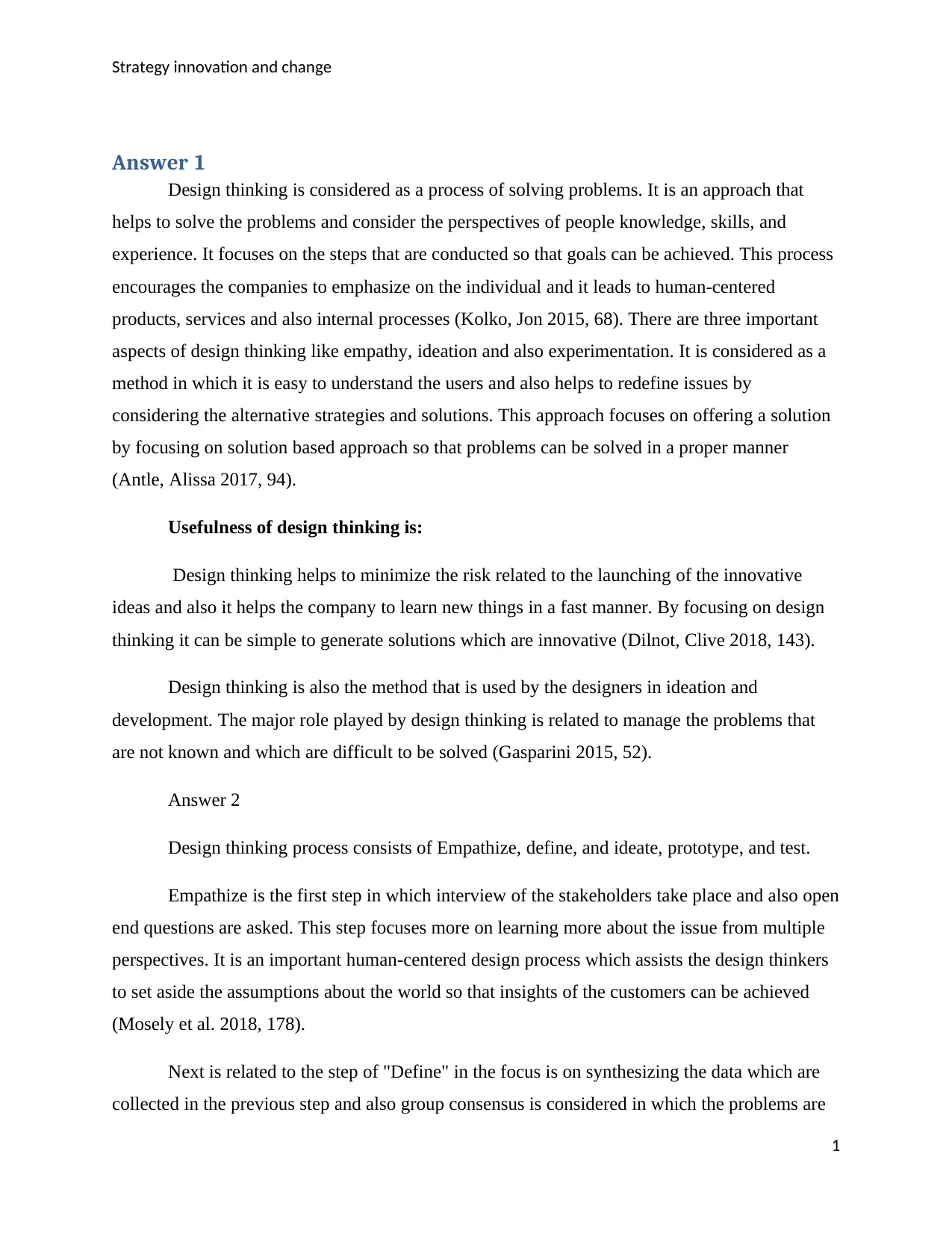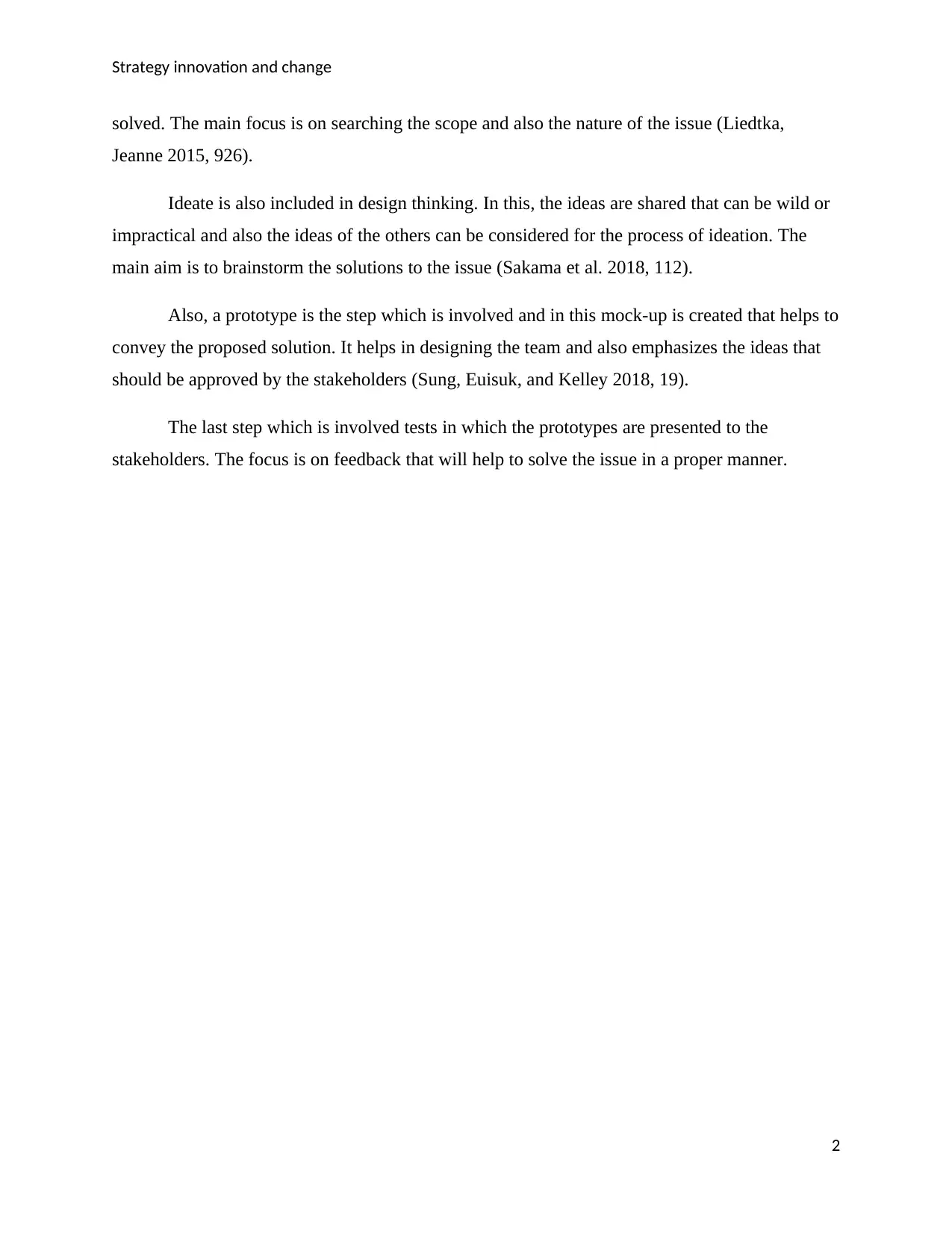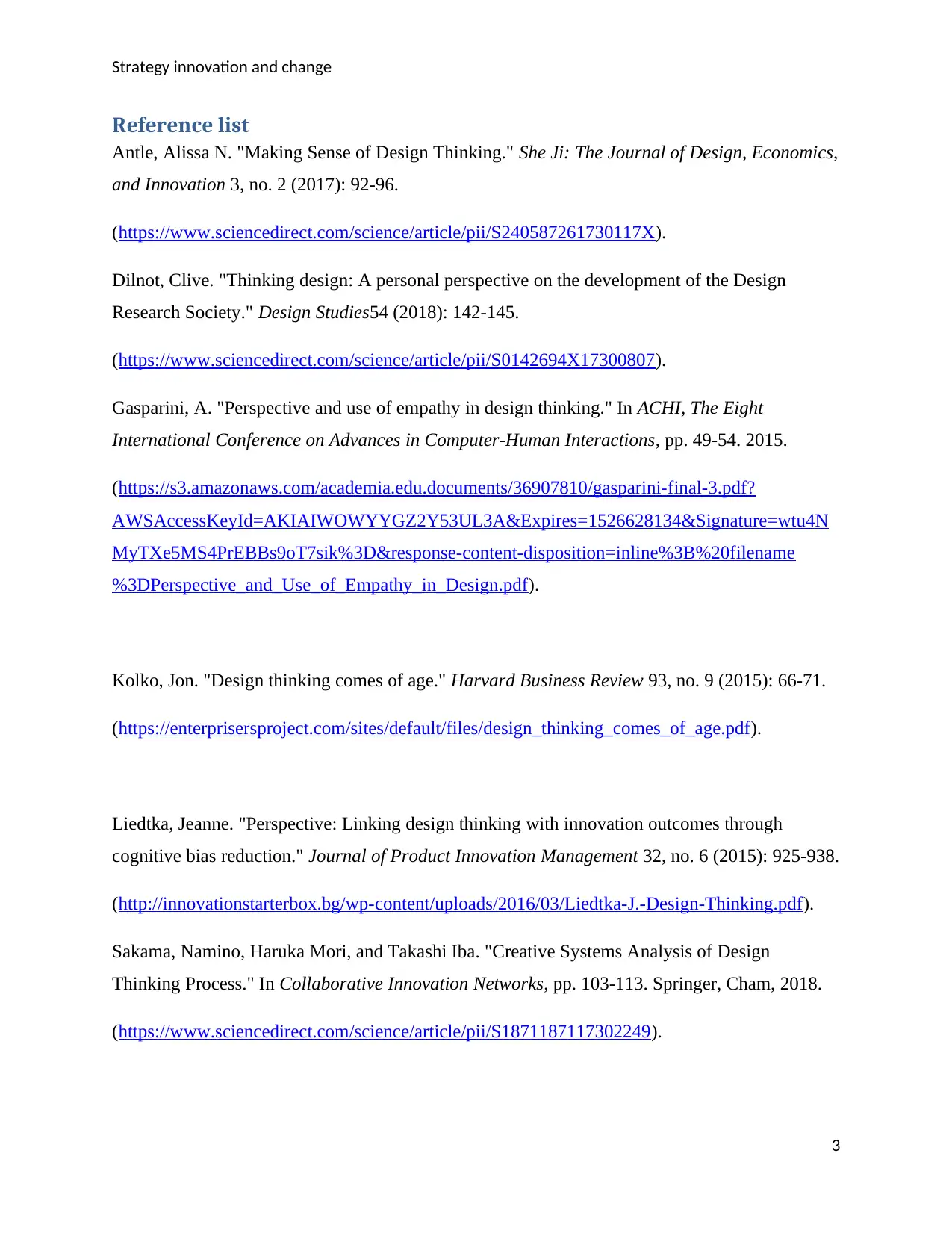Strategy Innovation and Change: Design Thinking Report Analysis
VerifiedAdded on 2021/06/17
|5
|876
|73
Report
AI Summary
This report examines design thinking as a problem-solving approach, emphasizing its importance in strategy innovation and change. It highlights key aspects such as empathy, ideation, and experimentation, and details the design thinking process, including empathize, define, ideate, prototype, and test phases. The report also explores the usefulness of design thinking in minimizing risks associated with innovation and generating creative solutions. It references several academic sources to support its claims, offering a comprehensive overview of the subject. The report underscores the human-centered nature of design thinking and its role in creating effective products, services, and internal processes within organizations. This assignment is a valuable resource for students studying business development.

Running head: Strategy innovation and change
Strategy innovation and change
Strategy innovation and change
Paraphrase This Document
Need a fresh take? Get an instant paraphrase of this document with our AI Paraphraser

Strategy innovation and change
Answer 1
Design thinking is considered as a process of solving problems. It is an approach that
helps to solve the problems and consider the perspectives of people knowledge, skills, and
experience. It focuses on the steps that are conducted so that goals can be achieved. This process
encourages the companies to emphasize on the individual and it leads to human-centered
products, services and also internal processes (Kolko, Jon 2015, 68). There are three important
aspects of design thinking like empathy, ideation and also experimentation. It is considered as a
method in which it is easy to understand the users and also helps to redefine issues by
considering the alternative strategies and solutions. This approach focuses on offering a solution
by focusing on solution based approach so that problems can be solved in a proper manner
(Antle, Alissa 2017, 94).
Usefulness of design thinking is:
Design thinking helps to minimize the risk related to the launching of the innovative
ideas and also it helps the company to learn new things in a fast manner. By focusing on design
thinking it can be simple to generate solutions which are innovative (Dilnot, Clive 2018, 143).
Design thinking is also the method that is used by the designers in ideation and
development. The major role played by design thinking is related to manage the problems that
are not known and which are difficult to be solved (Gasparini 2015, 52).
Answer 2
Design thinking process consists of Empathize, define, and ideate, prototype, and test.
Empathize is the first step in which interview of the stakeholders take place and also open
end questions are asked. This step focuses more on learning more about the issue from multiple
perspectives. It is an important human-centered design process which assists the design thinkers
to set aside the assumptions about the world so that insights of the customers can be achieved
(Mosely et al. 2018, 178).
Next is related to the step of "Define" in the focus is on synthesizing the data which are
collected in the previous step and also group consensus is considered in which the problems are
1
Answer 1
Design thinking is considered as a process of solving problems. It is an approach that
helps to solve the problems and consider the perspectives of people knowledge, skills, and
experience. It focuses on the steps that are conducted so that goals can be achieved. This process
encourages the companies to emphasize on the individual and it leads to human-centered
products, services and also internal processes (Kolko, Jon 2015, 68). There are three important
aspects of design thinking like empathy, ideation and also experimentation. It is considered as a
method in which it is easy to understand the users and also helps to redefine issues by
considering the alternative strategies and solutions. This approach focuses on offering a solution
by focusing on solution based approach so that problems can be solved in a proper manner
(Antle, Alissa 2017, 94).
Usefulness of design thinking is:
Design thinking helps to minimize the risk related to the launching of the innovative
ideas and also it helps the company to learn new things in a fast manner. By focusing on design
thinking it can be simple to generate solutions which are innovative (Dilnot, Clive 2018, 143).
Design thinking is also the method that is used by the designers in ideation and
development. The major role played by design thinking is related to manage the problems that
are not known and which are difficult to be solved (Gasparini 2015, 52).
Answer 2
Design thinking process consists of Empathize, define, and ideate, prototype, and test.
Empathize is the first step in which interview of the stakeholders take place and also open
end questions are asked. This step focuses more on learning more about the issue from multiple
perspectives. It is an important human-centered design process which assists the design thinkers
to set aside the assumptions about the world so that insights of the customers can be achieved
(Mosely et al. 2018, 178).
Next is related to the step of "Define" in the focus is on synthesizing the data which are
collected in the previous step and also group consensus is considered in which the problems are
1

Strategy innovation and change
solved. The main focus is on searching the scope and also the nature of the issue (Liedtka,
Jeanne 2015, 926).
Ideate is also included in design thinking. In this, the ideas are shared that can be wild or
impractical and also the ideas of the others can be considered for the process of ideation. The
main aim is to brainstorm the solutions to the issue (Sakama et al. 2018, 112).
Also, a prototype is the step which is involved and in this mock-up is created that helps to
convey the proposed solution. It helps in designing the team and also emphasizes the ideas that
should be approved by the stakeholders (Sung, Euisuk, and Kelley 2018, 19).
The last step which is involved tests in which the prototypes are presented to the
stakeholders. The focus is on feedback that will help to solve the issue in a proper manner.
2
solved. The main focus is on searching the scope and also the nature of the issue (Liedtka,
Jeanne 2015, 926).
Ideate is also included in design thinking. In this, the ideas are shared that can be wild or
impractical and also the ideas of the others can be considered for the process of ideation. The
main aim is to brainstorm the solutions to the issue (Sakama et al. 2018, 112).
Also, a prototype is the step which is involved and in this mock-up is created that helps to
convey the proposed solution. It helps in designing the team and also emphasizes the ideas that
should be approved by the stakeholders (Sung, Euisuk, and Kelley 2018, 19).
The last step which is involved tests in which the prototypes are presented to the
stakeholders. The focus is on feedback that will help to solve the issue in a proper manner.
2
⊘ This is a preview!⊘
Do you want full access?
Subscribe today to unlock all pages.

Trusted by 1+ million students worldwide

Strategy innovation and change
Reference list
Antle, Alissa N. "Making Sense of Design Thinking." She Ji: The Journal of Design, Economics,
and Innovation 3, no. 2 (2017): 92-96.
(https://www.sciencedirect.com/science/article/pii/S240587261730117X).
Dilnot, Clive. "Thinking design: A personal perspective on the development of the Design
Research Society." Design Studies54 (2018): 142-145.
(https://www.sciencedirect.com/science/article/pii/S0142694X17300807).
Gasparini, A. "Perspective and use of empathy in design thinking." In ACHI, The Eight
International Conference on Advances in Computer-Human Interactions, pp. 49-54. 2015.
(https://s3.amazonaws.com/academia.edu.documents/36907810/gasparini-final-3.pdf?
AWSAccessKeyId=AKIAIWOWYYGZ2Y53UL3A&Expires=1526628134&Signature=wtu4N
MyTXe5MS4PrEBBs9oT7sik%3D&response-content-disposition=inline%3B%20filename
%3DPerspective_and_Use_of_Empathy_in_Design.pdf).
Kolko, Jon. "Design thinking comes of age." Harvard Business Review 93, no. 9 (2015): 66-71.
(https://enterprisersproject.com/sites/default/files/design_thinking_comes_of_age.pdf).
Liedtka, Jeanne. "Perspective: Linking design thinking with innovation outcomes through
cognitive bias reduction." Journal of Product Innovation Management 32, no. 6 (2015): 925-938.
(http://innovationstarterbox.bg/wp-content/uploads/2016/03/Liedtka-J.-Design-Thinking.pdf).
Sakama, Namino, Haruka Mori, and Takashi Iba. "Creative Systems Analysis of Design
Thinking Process." In Collaborative Innovation Networks, pp. 103-113. Springer, Cham, 2018.
(https://www.sciencedirect.com/science/article/pii/S1871187117302249).
3
Reference list
Antle, Alissa N. "Making Sense of Design Thinking." She Ji: The Journal of Design, Economics,
and Innovation 3, no. 2 (2017): 92-96.
(https://www.sciencedirect.com/science/article/pii/S240587261730117X).
Dilnot, Clive. "Thinking design: A personal perspective on the development of the Design
Research Society." Design Studies54 (2018): 142-145.
(https://www.sciencedirect.com/science/article/pii/S0142694X17300807).
Gasparini, A. "Perspective and use of empathy in design thinking." In ACHI, The Eight
International Conference on Advances in Computer-Human Interactions, pp. 49-54. 2015.
(https://s3.amazonaws.com/academia.edu.documents/36907810/gasparini-final-3.pdf?
AWSAccessKeyId=AKIAIWOWYYGZ2Y53UL3A&Expires=1526628134&Signature=wtu4N
MyTXe5MS4PrEBBs9oT7sik%3D&response-content-disposition=inline%3B%20filename
%3DPerspective_and_Use_of_Empathy_in_Design.pdf).
Kolko, Jon. "Design thinking comes of age." Harvard Business Review 93, no. 9 (2015): 66-71.
(https://enterprisersproject.com/sites/default/files/design_thinking_comes_of_age.pdf).
Liedtka, Jeanne. "Perspective: Linking design thinking with innovation outcomes through
cognitive bias reduction." Journal of Product Innovation Management 32, no. 6 (2015): 925-938.
(http://innovationstarterbox.bg/wp-content/uploads/2016/03/Liedtka-J.-Design-Thinking.pdf).
Sakama, Namino, Haruka Mori, and Takashi Iba. "Creative Systems Analysis of Design
Thinking Process." In Collaborative Innovation Networks, pp. 103-113. Springer, Cham, 2018.
(https://www.sciencedirect.com/science/article/pii/S1871187117302249).
3
Paraphrase This Document
Need a fresh take? Get an instant paraphrase of this document with our AI Paraphraser

Strategy innovation and change
Sung, Euisuk, and Todd R. Kelley. "Identifying design process patterns: a sequential analysis
study of design thinking." International Journal of Technology and Design Education(2018): 1-
20.
(https://link.springer.com/article/10.1007/s10798-018-9448-1).
4
Sung, Euisuk, and Todd R. Kelley. "Identifying design process patterns: a sequential analysis
study of design thinking." International Journal of Technology and Design Education(2018): 1-
20.
(https://link.springer.com/article/10.1007/s10798-018-9448-1).
4
1 out of 5
Related Documents
Your All-in-One AI-Powered Toolkit for Academic Success.
+13062052269
info@desklib.com
Available 24*7 on WhatsApp / Email
![[object Object]](/_next/static/media/star-bottom.7253800d.svg)
Unlock your academic potential
Copyright © 2020–2025 A2Z Services. All Rights Reserved. Developed and managed by ZUCOL.



